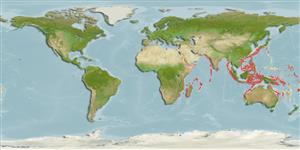>
Perciformes/Bembropoidei (Duckbill flatheads) >
Bembropidae (Duckbill flatheads)
Etymology: Bembrops: Greek, bembras, -ados = a kind of anchovy m+ Greek, ops = appearance (Ref. 45335); platyrhynchus: Specific name from the Greek 'platys' meaning flat and 'rhynchos' meaning snout or beak..
More on author: Alcock.
Issue
Hoese and Bray (2006: in Ref. 75154) reccognize Bembrops philippinus as valid. It seems no new information has been published since under that name, or under Bembrops platyrhynchus.in the Philippines. Please send papers we missed, or more studies are needed.
Environment: milieu / climate zone / depth range / distribution range
पारिस्थितिकी
समुद्री बाथीड़िमरसल; गहराई सीमा 200 - 549 m (Ref. 26165). Deep-water
Indo-West Pacific: including the Bay of Bengal, the South China Sea, the Philippine Sea, the Tasman Sea, and off the coast of Somalia and South Africa.
आकार / वज़न / Age
Maturity: Lm ? range ? - ? cm
Max length : 25.0 cm TL पुल्लिंग / अलिंग; (Ref. 6652)
पृष्ठीय रीढ़ (सम्पूर्ण) : 6; पृष्ठीय सौफट रेज़ (सम्पूर्ण) : 14 - 15; गुदा कांटा: 0; ऐनल सौफट रेज़: 15 - 16. Vague dusky spots along body, 1 on caudal fin at base of upper rays; scales edged with black; 1st dorsal fin dusky to black in color (Ref. 6652). Distal margin of first dorsal fin darkish. Usually 5 scale rows between lateral line and origin of anal fin (Ref 12932).
Inhabits offshore trawling grounds (Ref. 3132).
Life cycle and mating behavior
Maturities | पुनरुत्पत्ति | Spawnings | Egg(s) | Fecundities | लार्वा
Das, M.K. and J.S. Nelson, 1996. Revision of the percophid genus Bembrops (Actinopterygii: Perciformes). Bull. Mar. Sci. 59(1):9-44. (Ref. 13203)
IUCN Red List Status (Ref. 130435)
Threat to humans
Harmless
Human uses
साधन
Special reports
Download XML
इंटरनेट स्रोत
Estimates based on models
Preferred temperature (Ref.
123201): 9.8 - 17.3, mean 12.5 °C (based on 197 cells).
Phylogenetic diversity index (Ref.
82804): PD
50 = 0.5000 [Uniqueness, from 0.5 = low to 2.0 = high].
Bayesian length-weight: a=0.00363 (0.00177 - 0.00744), b=3.12 (2.94 - 3.30), in cm total length, based on LWR estimates for this species & (Sub)family-body (Ref.
93245).
Trophic level (Ref.
69278): 4.1 ±0.5 se; based on size and trophs of closest relatives
Fishing Vulnerability (Ref.
59153): Low vulnerability (15 of 100).
